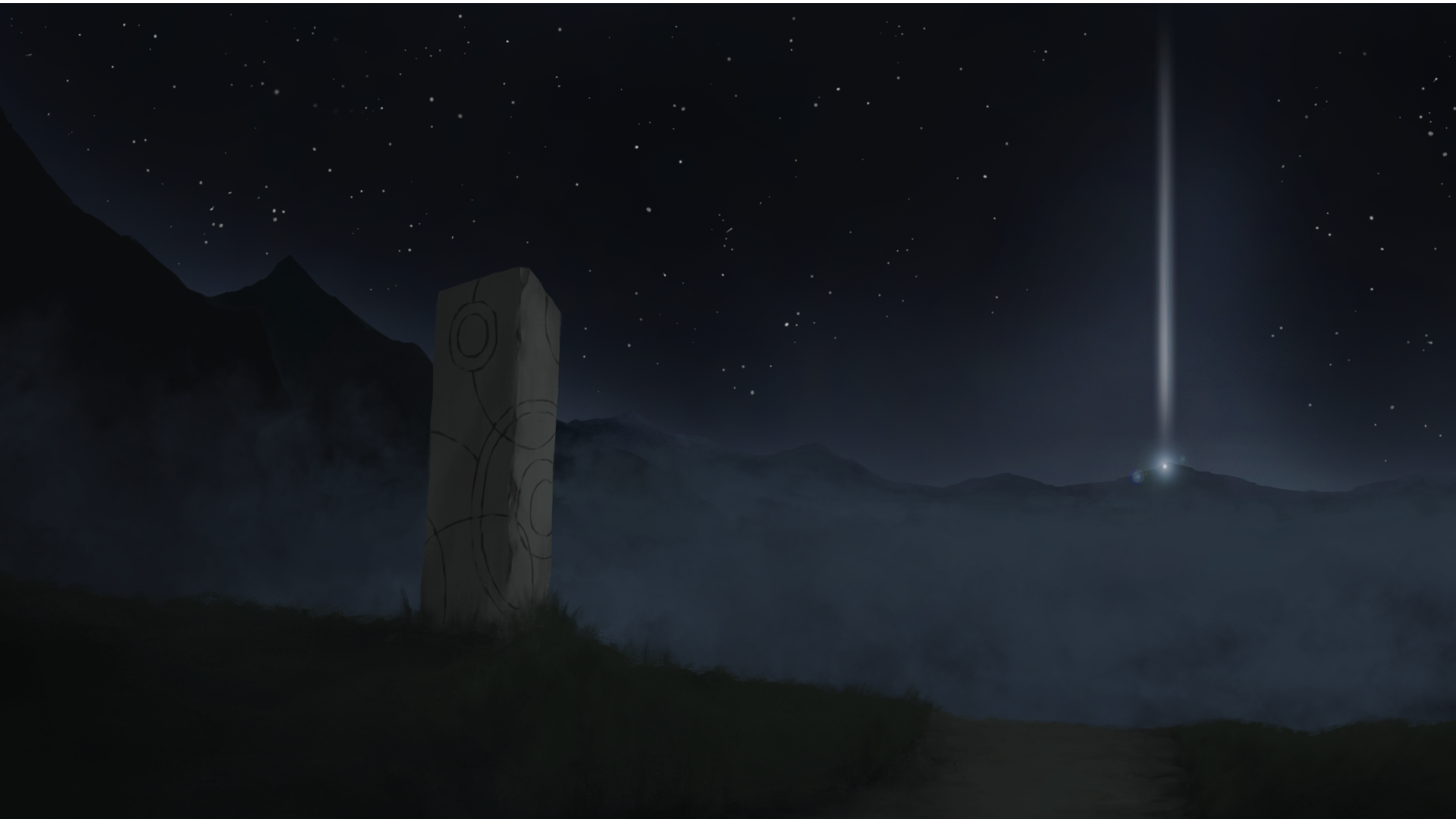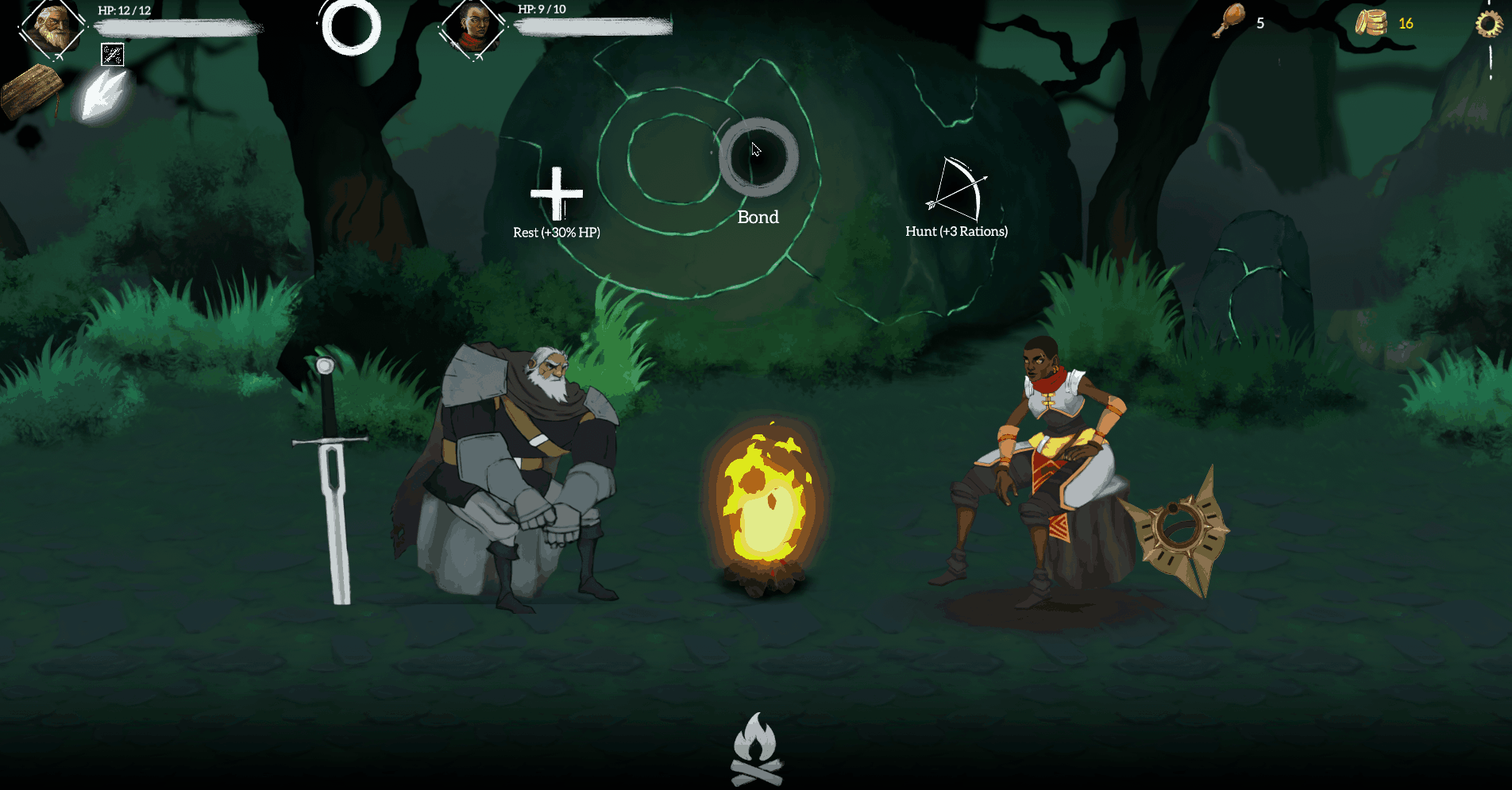
the furrow
A narrative-driven roguelike RPG that sets the story of two strangers learning to trust each other against the sweeping tale of a mysterious valley.
As Lead Narrative Designer and Writer for The Furrow, I developed a layered, branching narrative system that fed into and supported the mechanics of a roguelike while allowing my world lore and character designs to shine. This project also allowed me to practice maintaining story continuity throughout branching, partially-randomized dialogue.
The Furrow was developed in Unity in 2019 for a 13-week class at Simon Fraser University.
JUMP TO:
worldbuilding // character design // narrative design // game design // writing // art // music & sound
Make sure to follow the quick start guide!
the team [we are wizards]
JULES LOUGHIN
Narrative Designer & Writer
Co-Game Designer
Music & Sound Lead
Art Assist.
the concept
Having noticed that popular indie roguelikes often sacrifice narrative in order to focus on mechanics and dynamics (as of 2019), we set ourselves a design challenge: to create a roguelike with an embedded narrative system.
worldbuilding
The team decided upon a dark, fantastical valley as the setting for the game, and it was my job to develop the lore for such a place. I wrote several short worldbuilding stories, and together the team selected my tale of Titans, heroes, star magic, and slow madness.
character design
To design our two main characters, I began by writing several brief character outlines. From there, we chose the two with the most potential for an interesting interpersonal dynamic: the “Old Tired Legend” and the “Young Hungry Wannabe”. From there, I filled out the characters' backstories and motivations.
The "Legend" (Aldric) wishes to end his journey as a hero, pressured to conform to the image others have built of him -- even in his death.
The "Wannabe" (Ide) is unaware that the old man she travels with is the very hero who inspired her path to legendhood.
narrative design
The core challenge I faced as Narrative Designer for The Furrow was that of designing an embedded narrative with roguelike randomness and replayability in mind. My aim for this undertaking was to create a narrative system that would support these typically story-thwarting mechanics, not just function “despite” them.
I tackled this challenge by first separating the embedded narrative from the randomized events that populate the map, creating two narrative layers:
ENCOUNTERS: These are randomized, self-contained narrative nodes that reveal the secrets of the valley, sometimes branching into decisions and sometimes leading into combat. During Encounters, players can earn or lose Bond Points, rations, gold, and artifacts.
BOND MOMENTS: When the player accrues enough Bond Points, they can unlock a Bond Moment— a campfire conversation between the main characters. With each Bond Moment, their relationship grows, and the player can choose a new combat skill for one of their characters.
These two layers feed into each other in a loop: Encounters earn Bond Points, which unlock Bond Moments, which unlock new combat skills, which are used in Encounters. Meanwhile, the narrative content of each layer is independent, eliminating the out-of-scope challenge of creating an embedded narrative that can respond dynamically to the randomized order of events in the game.
CHALLENGE: STRUCTURING THE BOND NARRATIVE
Since roguelikes require multiple attempts to beat, the Bond Moment narrative layer needed to vary with every playthrough.
My initial branching prototype showed me that achieving that variety purely through choice-based branching was causing playtesters to make arbitrary decisions on consecutive playthroughs in order to experience different narrative paths. Also, the uncontrolled branching demanded a quantity of writing that was out of scope for our tight timeline.
My solution: a foldback structure with a mix of choice and randomness. The foldback structure controlled the number of branches I would need to write, while the randomness mitigated the issue of arbitrary decision-making, providing a different path through the narrative with each playthrough.
game design
Logan, Quinn and I worked together to develop the mechanics for The Furrow. Pictured above are two examples of our collaboration: the paper prototype we developed to test our core loop, and the spreadsheet we used to design our characters’ combat skills. Our approach was cross-disciplinary:
I provided narrative-focused input, ensuring that all additions to the game were on-theme and continuously updating the narrative system to support our evolving mechanics.
Logan contributed his understanding of systems design and programming, also acting as project manager to keep us within-scope and on-task.
Quinn brought his artistic sensibilities to the table, helping us to imagine how each mechanic would play out on-screen and pointing out art-related constraints.
writing
One of my biggest jobs during the production phase of the game was to write all the narrative content for the game. This included both the prose presented for each Encounter and the dialogue spoken between Aldric and Ide during the Bond Moments.
ENCOUNTER WRITING
The challenge for the Encounters was to quickly produce dozens of varied, interesting story nodes, a subset of which would be displayed in pseudo-random order to the players with each run. These encounters had to present engaging, balanced choices, and enough of them had to contain allusions to the lore of the valley to form a broader picture of how The Furrow came to be.
BOND MOMENT WRITING
There are five Bond Moments in the game. Within my partially-randomized foldback structure, there are two types of Moments:
Moments 1, 3, and 5 are longer and contain some controlled branching, presenting the player with dialogue options at key points in the conversation. These Moments mark the three “acts” of the interpersonal tale between Aldric and Ide — the setup (1), the conflict (3), and the resolution (5).
Moments 2 and 4 are shorter and do not contain dialogue options. These Moments are randomly selected from a pool of possible conversations, and are generally more lighthearted and less narratively consequential than the branching moments. They serve to shed some light on Aldric and Ide, revealing aspects of their backstories, personalities, or interpersonal dynamic.
The key to writing the Bond Moments was to ensure that each branch — be it choice-driven or randomized — feels completely different for sake of replayability, but contains the same information so as to flow identically into the next Bond Moment. Writing good dialogue within these constraints was challenging, but it was worth the effort.
art
While Quinn was busy with the artwork and animations for all the Combat and Bond Moment scenes, I took on the UI and some of the still artwork — this included the map artwork, the HUD, the dialogue boxes, the item artwork, some of the Encounter splash art, and the character portraits.
music & sound
One of my goals for this project was to create the music and sound from scratch. With such a tight schedule, I had to rely largely on improvisation, and only allowed myself a couple days to both record everything with Logan’s help and mix it in Audition.
I gave the music a modal feel to evoke the hollow darkness of the Furrow, taking inspiration from Norse and Celtic folk music. I also designed the sounds for the UI and combat, which Logan implemented using FMOD.
takeaways
This game felt more like a passion project than an assignment for school, and I am grateful to have had the chance to work with such talented friends as Logan and Quinn. I can see each of us in this game, and am proud of all the creativity I poured into it with my narrative design and writing.
On a personal level, this game showed me that I am capable of thoughtful, intricate game and narrative design. It reinforced my love for worldbuilding and lore, and reminded me of how good it feels to work alongside like-minded, passionate peers.
Jason Procyk of Electronic Arts — our industry mentor and an alumnus of the SIAT program at SFU — had this to say of The Furrow:
“This project is exemplary. It is among the best work (if not the best) I have seen come out of the SIAT program. I particularly appreciate the [team’s] holistic effort, ingenuity and quality, humility and transparency, and drive to learn.”




